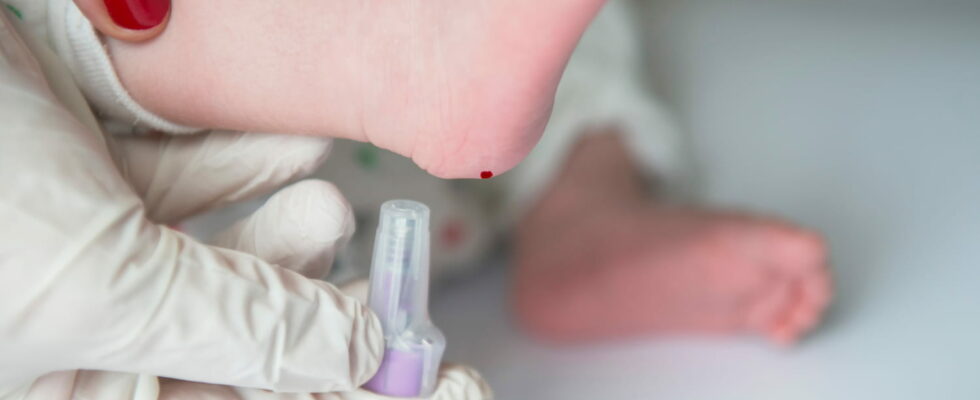Newborn screening is performed by taking drops of blood, after a small prick in the newborn’s heel.
Every newborn in France takes part in the national newborn screening program to detect rare, severe diseases, most often of genetic origin. Following the recommendations of the High Authority for Health, the sickle cell diseasethe most common genetic disease among those detected at birth, is systematically screened for in all newborns according to a decree published in Official Journal from August 3, 2024. Previously, its screening was subject to conditions.
What is newborn screening?
Established in the early 1970s, the newborn screening test was initially limited to screening for phenylketonuria in 1972 then it was extended to thecongenital hypothyroidism in 1978, to the Sickle cell disease in Overseas Territories in 1985 and 10 years later in a targeted manner in metropolitan France,Congenital adrenal hyperplasia in 1995to the cystic fibrosis in 2002 and to the permanent bilateral deafness in 2012. It is realized by taking drops of blood on a blotting paper, after a small prick in the heel of the newborn. It is systematically proposed and carried out after the parents’ agreement. The sample is most often taken in the maternity ward, sometimes at home, within 3 days of birth. Results are only communicated to parents in the event of a problem. “The Guthrie Test also allows to detect if the child is a “carrier” without being sick (healthy carrier), for example for sickle cell disease and cystic fibrosis“, explains Dr. Monique Quillard, general practitioner and pediatrician. The diseases detected are: rare and genetic diseasesthe list of which is fixed by ministerial decree.
13 rare diseases sought
- Phenylketonuria: The body of people with phenylketonuria cannot process phenylalanine, a protein present in the body and in food. It accumulates and, in excess in the body, it prevents the proper development of the child’s brain, causing cognitive disorders and psychomotor delay.
- congenital hypothyroidism: this is a deficiency in the production of the thyroid hormones T3 and T4, either because the newborn’s gland has not developed properly or because it is dysfunctional.Without treatment, it can lead to psychomotor development disorders and irreversible growth disorders.” says Dr. Quillard.
- Cystic fibrosis: this genetic disease responsible for breathing difficulties affects 1 in 4,000 newborns in France. It causes an absence or dysfunction of the CFTR protein: this leads to the formation of mucus that solidifies in the organs. The microbes are poorly evacuated, they stagnate, cause infections and an inflammatory state responsible, little by little, for the destruction of the lungs and significant digestive problems. The sick person breathes poorly, has the sensation of suffocating while suffering from severe abdominal pain, digestive problems and episodes of diarrhea. There is no curative treatment.
- congenital adrenal hyperplasia: This is a dysfunction of the adrenal glands.It causes poor production of certain hormones, mainly sexual, either in excess or in deficit. In the absence of treatment, it causes disturbances in growth and puberty.“, our expert specifies.
- MCAD deficiency: This is a hereditary disease characterized by the body’s inability to use certain fats (fatty acids) as an energy source. Through screening at birth, an adapted diet can prevent complications from this disease and allow the child to develop normally.
- sickle cell disease : This is a hereditary genetic disease affecting the hemoglobin chains. The red blood cells are deformed, they take on a sickle shape. Because of this shape, they circulate poorly, which can cause clots in the vessels, causing many complications such as anemia, bone infarctions, greater sensitivity to infections, etc.Nearly 120 million people worldwide are thought to carry a sickle cell mutation. In metropolitan France, there are 6,000 to 7,000 people affected, with 250 new cases diagnosed each year, especially in the Paris region.“, says Dr. Quillard.
- homocystinuria (HCY) (since January 1, 2023)
- leukemia (MSUD) (since January 1, 2023)
- tyrosinemia type 1 (TYR-1) (since January 1, 2023)
- isovaleric aciduria (IVA) (since January 1, 2023)
- glutaric aciduria type 1 (GA-1) (since January 1, 2023)
- long-chain fatty acid 3-hydroxyacyl-coenzyme A dehydrogenase (LCHAD) deficiency (since January 1, 2023)
- carnitine uptake deficiency (CUD) (since January 1, 2023)
Thanks to Dr. Monique Quillard, general practitioner and pediatrician.
